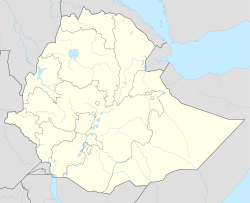Gore, Ethiopia
|
Gore ጎሬ |
|
|---|---|
| Town | |
| Location within Ethiopia | |
| Coordinates: 8°9′N 35°31′E / 8.150°N 35.517°ECoordinates: 8°9′N 35°31′E / 8.150°N 35.517°E | |
| Country | Ethiopia |
| Region | Oromia |
| Zone | Illubabor |
| Elevation | 2,085 m (6,841 ft) |
| Population (2005) | |
| • Total | 12,708 |
| Time zone | EAT (UTC+3) |
Gore is a town in south-western Ethiopia. Located south of Metu in the Illubabor Zone of the Oromia Region, this town has a latitude and longitude of 8°9′N 35°31′E / 8.150°N 35.517°E and an elevation of 2085 meters.
Gore is known for its honey. The map attached to C. W. Gwynn's account of his 1908/09 triangulation survey of southern Ethiopia shows that Gore had a telegraph station. During the 1960s, experimental tea plantations were started around Gore in the 1960s, and a number of them thrived. The Gummaro plantation near Gore, with 800 hectares, is the largest tea plantation in Ethiopia.
The town is served by Gore Airport.
Gore was founded in the nineteenth century, growing up around Ras Tessema Nadew's palace. The Russian explorer Alexander Bulatovich stopped here 21 November 1896, expecting to meet Ras Tessema, who was away campaigning against the Mocha; Ras Tessema had not returned when Bulatovich left on 31 December. With the growing prosperity of the port town of Gambela, and the growth of the Baro River route to Sudan, Gore likewise prospered, holding two market days a week. Richard Pankhurst describes the pre-World War I community as having five foreign trading concerns -- "two Greek, one Syrian, one British and one German"—engaged in the export of coffee, wax, and to a lesser extent animal hides, and the import of cotton cloth, salt, and other manufactured goods. Civet cat oil was also a significant export at the time, Pankhurst noting that Ras Tessema exported 42 kilos in 1910.
...
Wikipedia

